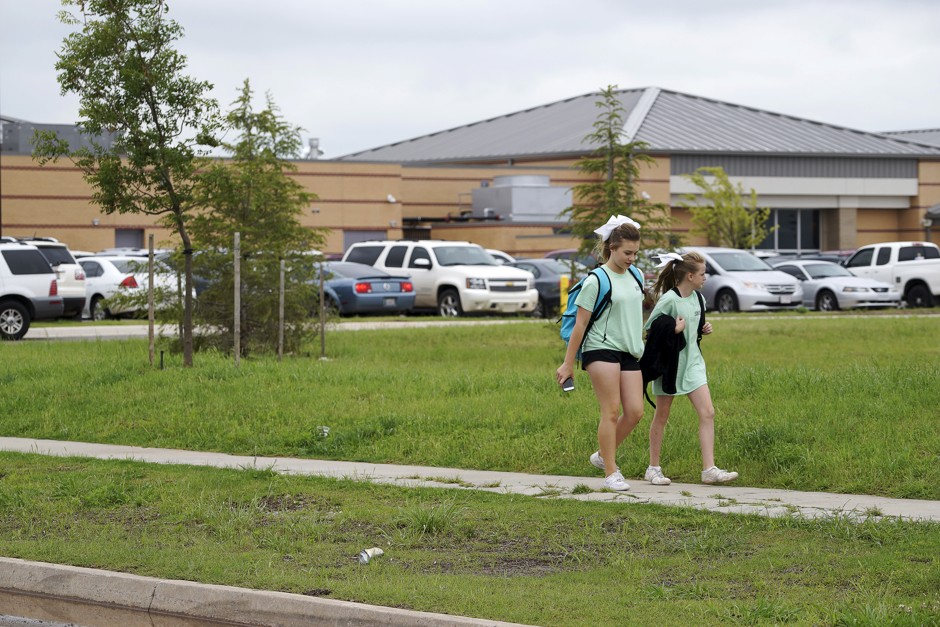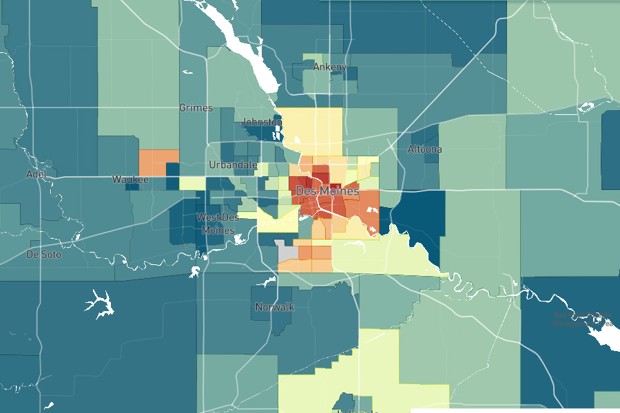
An elementary school in Oklahoma City. Photo by Rick Wilking/Reuters .

Source: The Opportunity Atlas .
What matters is not just whether a county is urban or rural but how far it is from a large urban or metropolitan center. Yet, close proximity to an urban center does not increase economic mobility, Weber, et al. found. Instead, upward mobility declines with proximity to a major urban center. And, the further away a place is, the higher the economic mobility. In other words, upward mobility is a function of remoteness.
In an email conversation with me, Nathan Hendren, one of Chetty’s collaborators and coauthors, pointed out that, “In general, we do find that youngsters growing up in rural areas tend to have higher rates of upward economic mobility. This tends to be the general pattern across the U.S.” He added that, “It’s interesting that distance from a metro area is positively correlated with mobility.”
A number of other factors bear on the upward economic mobility of children from urban and rural areas. For one, living closer to work, reflected in short commutes (of less than 15 minutes), has a much bigger effect on upward mobility in rural than in urban counties. This may be because jobs and economic opportunities are more spread out in rural areas, and families living in them may benefit from living closer to those opportunities.
Even the smallest amount of income inequality leads to a large decrease in upward mobility for urban youth. For rural youth, that impact is twice as large, even though income inequality is greater in urban areas. And growing up in a home headed by a single mother has a more adverse effect on kids from rural counties than ones in urban counties. The disproportionate role these two factors have on upward mobility in rural communities may reflect the fact that these areas lack the social services and safety nets available in urban areas. Conversely, the high school dropout rate has much less of an effect on mobility in rural areas than on urban counterparts.
Based on their broader analysis, which controls for these various factors, Weber and company conclude that if factors like income inequality and high school dropout rates were the same in urban and rural counties, upward mobility would be even higher for rural places, pointing out that the higher upward mobility of rural places is likely due to their “more favorable conditions” on factors like family structure, inequality, commuting, and social capital.
Additional work from Chetty’s team adds additional nuance by zeroing in on the effects of census tracts (an even smaller geographic unit than counties) on economic mobility. Co-authored with Hendren of Harvard, John Friedman of Brown, and Maggie Jones and Sonya Porter of the U.S. Census Bureau, it echoes the findings of sociologists like Robert Sampson of Harvard University and Patrick Sharkey of New York University, on the power of “neighborhood effects.”
Chetty and his collaborators find that it is not just the metro or county a child grows up in, but the specific neighborhood that matters. The prospects for economic mobility can and do vary greatly from neighborhood to neighborhood, even within the same metro or county. As they put it: “The sharply divergent patterns of opportunity across the country suggest that the underlying drivers (as well as potential policy solutions) may also vary greatly from place to place.”
Furthermore, the differences in upward mobility between urban and rural neighborhoods tend to differ across various parts of the country. David Williams, policy director for Opportunity Insights, points to the differences between the Midwest and the South as examples of this pattern. In Iowa and the Dakotas, rural areas afford much greater prospects for upward mobility compared to urban centers. But in Georgia and the Carolinas, rural areas offer much less opportunity for economic mobility than urban centers.

Low-income youth from the rural outskirts of Des Moines, Iowa, have better upward economic mobility than kids from the urban core. Source: The Opportunity Atlas .

Raleigh, North Carolina, tells a different picture. Kids closer to the city center have better upward economic mobility than those from the rural outskirts. Source: The Opportunity Atlas .
“It kind of complicates our narrative of the urban-rural divide,” says Williams. “There are good and bad things happening in both urban and rural places across the country,” he says, noting that these differences may offer a way both to learn what works and what doesn’t, in order to help bridge our political divide.
The reality of economic mobility defies what we think of as our urban-rural divide. It may even offer an opportunity for each type of place to begin to learn from the other.
CityLab editorial fellow Claire Tran contributed research and editorial assistance to this article.
Richard Florida is a co-founder and editor at large of CityLab and a senior editor at The Atlantic. He is a university professor in the University of Toronto’s School of Cities and Rotman School of Management, and a distinguished fellow at New York University’s Schack Institute of Real Estate and visiting fellow at Florida International University.